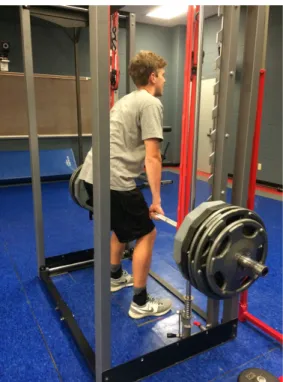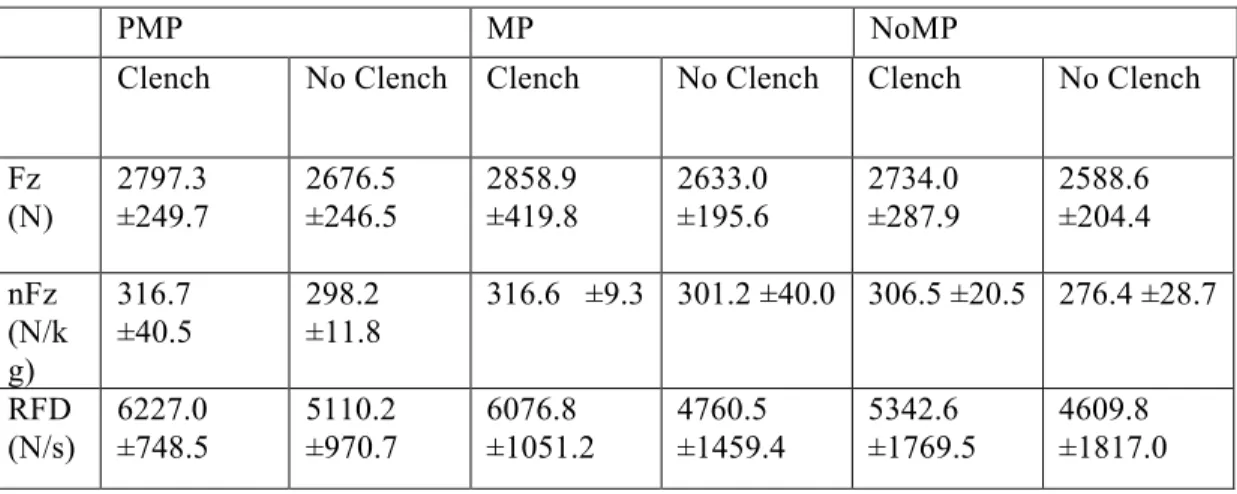Under the mouthpiece idea, researchers were able to identify two different ideas that led to improvements in power and RFD. The first idea suggested realigning the temporomandibular joint (TMJ) by wearing a mouthpiece. In Kaufman's study, he was able to show improvements in vertical jump height, muscle strength, balance and agility in soccer players due to the use of the mouthpiece.
Similarly, Kaufman found ways to relieve headaches and increase the repulsive power of members of the US Olympic bobsled team by wearing the mouthpiece (Kaufman, 1980). This meant that by clenching the jaw and activating that area of the motor cortex, the subject's legs would experience an increase in strength through a simultaneous activation of the muscle fibers of the lower limbs. Time to Peak Force: The recorded time from the start of the trial to the time when the peak force was recorded.
Force Plate: A part of the floor that can analyze the amount of force applied to it. In all cases he examined, wearing the mouthpiece led to an improvement in jaw position, further resulting in superior athletic performance. In this study, Smith attempted to obtain objective evidence pointing to a relationship between muscle strength and jaw posture and condition.
This was intended to give Smith any signs of a correlation between the subject's TMJ history and the results of the rest of the study. The results of the study showed that 32% of the subjects clenched and ground their teeth. The data showed an increase in strength once the subject's mouthpiece was adjusted, furthering the validity of some of the questions Smith proposed about the effects of wearing a particular mouthpiece during exercise.
Subjects reported that wearing the bimaxillary mouthpiece did not further restrict airflow. Improved blood flow and neural transmission along the TMJ when wearing the mouthpiece can potentially increase oxygenated blood flow to other areas of the head and neck. The results of the study showed significant improvements in VO2, VO2/kg and VCO2 in the subjects wearing the mouthpiece.
In one of the more recent studies, Allen (2014) investigated the effects of wearing a voicemail on various markers of physical performance, including functional balance, maximal muscle force production during a bench press exercise, and muscle power during a jump. vertical counter movement (CMVJ) (Allen, 2014). Because of these arguments of conflicting evidence, researchers branched out further into the field, examining the possibilities and other effects of sound. For example, recent studies have shown an increase in limb, neck, and back musculature, best explained by a process called concurrent activation potentiation (CAP) (Ebben, 2006).
The results showed that the RVCs produced a performance improvement of the closed kinetic chain exercises by a value of 2.9-32.3%.
METHODS METHODS
Under both of these conditions, the subject's maximal isometric strength was assessed via the isometric mid-thigh clean pull (iMTCP). Isometric clean pull rating was measured using a Jones machine (BodyCraft, Inc., Sunbury, OH, USA), which was modified to fix the bar so that it could not move. This allowed the subject's strength to be transferred to the force plate (ground reaction force) on which he stood while performing the clean move.
The subject used nylon weightlifting straps to secure his hands to the bar, holding the bar with a double, overhand, closed grip, with the thumb wrapped around the bar. The nylon straps were used to negate the potential benefits of subjects with larger hands and greater grip strength. When instructed, the subject performed the pure pull for a maximum of three seconds, with thirty seconds of rest between attempts.
The GRF was the force exerted by the subject's legs on the force platform during the clean pull. The force platform analyzed the subject's clean pull attempts and used the collected data to calculate variables such as peak force, rate of force development, and ground reaction force. Peak force was defined as the maximum muscle force production recorded by the force plate during the experiment.
Rate of force development was defined as how quickly the subject could produce the force analyzed during the individual trials and was used to correlate force output. All clean pull tests were performed from a 600mm x 400mm force platform (Bertec Inc., Columbus, OH, USA). The GRF data was used to identify the vertical peak force (Fz) value, normalized peak force (nFz) and rate of force development (RFD).
The RFD described how quickly the subject was able to produce the required force. Normalized peak force was determined by dividing the peak force by the subject's body weight, expressed as a function of body weight (nFz). e) Statistical analysis. A sampling rate of 1000 Hz was used for the study, along with an interaction, and main significance was analyzed by performing a 3 x 2 ANOVA (mouthpiece x compression condition) for repeated measures.

RESULTS
Peak Vertical Force
Normalized Peak Force
Rate of Force Development
The aim of this study was to investigate the effects of wearing a voice and jaw brace on strength and RFD during an iMTCP. According to the ideas behind MORA, the vocal wear would not only relieve the stress placed on the TMJ, but also reduce athletic stress, yielding higher amounts of strength. Other studies showed that mouth wear can improve other areas of exercise, such as post-exercise cortisol levels and improved muscular endurance (Garner, 2011).
After evaluating the data, several conclusions can be drawn as to why wearing a mouthpiece and clenching the jaw did not lead to improved muscle strength. Therefore, it is possible that the mouthpiece and jaw clenching effects simply did not dominate in these three subjects, but do dominate in others. Additionally, it is possible that the mouthpieces used did not actually place the subject's jaw in an optimal position.
This ensured that the mouthpiece was working properly and that the TMJ was properly aligned. When the mouthpiece was used in sporting events, there was plenty of time for the TMJ to adjust and the CAP to have its effect, but in the case of a single IMTCP, it is possible that there was not enough time for the subject to receive any advantages for the pure draft. First, for the mouthpiece to have its effect, it is necessary for the subject to have a professional dentist adjust his mouthpiece.
It is also necessary that the subject uses the mouthpiece and can clench the jaw in a situation where there is enough time for the CAP to have its proper effect on the subject. Further guidance and research in this area is ultimately needed to better understand the effects of TMJ realignment and CAP in cases of power. Finally, it would be beneficial to design the study in such a way that the subject would have time for the effects of CAP to be seen.
In conclusion, the results of this study have shown that the acute effects of stretching the TMJ and CAP during a voice hold and jaw clenching do not lead to improvements in force production during an iMTCP. Ultimately, further research is required to more fully understand this phenomenon, with more emphasis placed on the number of participants involved in the study, how the voice is aligned in each individual participant, and under what conditions of muscle activity the throat is used. . Effects of oral use on cortisol levels during an intense bout of resistance exercise.
Effects of mouthpiece use on auditory and visual reaction time in college men and women. The effects of mouthpiece use on gas exchange parameters during steady-state exercise in college-aged men and women.

